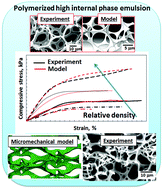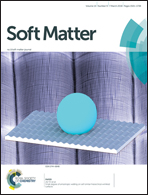Modeling compressive behavior of open-cell polymerized high internal phase emulsions: effects of density and morphology
Abstract
The compressive behavior of poly(HIPE) foams was studied using the developed micromechanics based computational model. The model allowed identifying the morphological parameters governing the foam compressive behavior. These parameters comprise: (i) foam density, (ii) Sauter mean diameter of voids calculated from the morphological analysis of the polydispersed microstructure of poly(HIPE), and (iii) polymer/strut characteristic size identified as the height of the curvilinear triangular cross-section. The model prediction compared closely with the experiments and considered both the linear and plateau regions of the compressive poly(HIPE) behavior. The computational model allows the prediction of structure–property relationships for poly(HIPE) foams with various relative densities and open cell microstructure using the input parameters obtained from the morphology characterization of the poly(HIPE). The simulations provide a pathway for understanding how tuning the manufacturing process can enable the optimal foam morphology for targeted mechanical properties.



 Please wait while we load your content...
Please wait while we load your content...